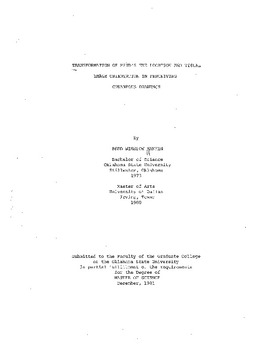| dc.contributor.advisor | Weber, Robert J. | |
| dc.contributor.author | Mankin, Reed Winslow | |
| dc.date.accessioned | 2015-08-27T16:44:19Z | |
| dc.date.available | 2015-08-27T16:44:19Z | |
| dc.date.issued | 1981-12-01 | |
| dc.identifier.uri | https://hdl.handle.net/11244/16787 | |
| dc.description.abstract | Imagery is an important area of study for a number of reasons. First, many issues regarding the structure and function of images have yet to be clarified. Second, studying the nature of imagery can provide information on the structure of memory, attention, and other more broad aspects of cognitive psychology. Third, understanding the processes underlying imagery provides important information concerning how people solve practical problems in everyday living. This thesis deals with the question of how images are rotated and how a person's mental point of reference is transformed. The processes underlying such behavior have hopefully received at least some clarification. | |
| dc.format | application/pdf | |
| dc.language | en_US | |
| dc.publisher | Oklahoma State University | |
| dc.rights | Copyright is held by the author who has granted the Oklahoma State University Library the non-exclusive right to share this material in its institutional repository. Contact Digital Library Services at lib-dls@okstate.edu or 405-744-9161 for the permission policy on the use, reproduction or distribution of this material. | |
| dc.title | Transformation of Mind's Eye Location and Visual Image Orientation in Perceiving Cutaneous Drawings | |
| dc.type | text | |
| dc.contributor.committeeMember | Stanners, Robert F. | |
| dc.contributor.committeeMember | Jaynes, William E. | |
| osu.filename | Thesis-1981-M278t.pdf | |
| osu.accesstype | Open Access | |
| dc.description.department | Psychology | |
| dc.type.genre | Thesis | |
